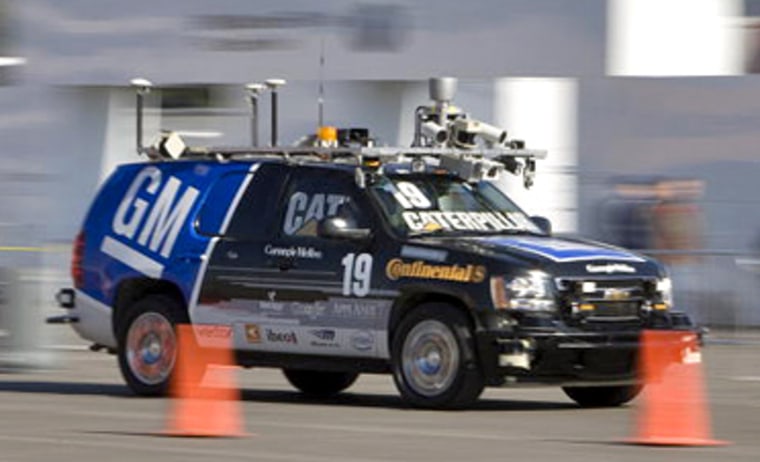It looked like a typical California suburb of curving roads, culs-de-sac, and single-story stucco homes. But the houses were abandoned, with empty rooms and broken windows. Out on the streets, eerily well-behaved cars and S.U.V.’s were merging, passing, and parking under the hot sun.
This was the Darpa Urban Challenge, a Department of Defense competition held in November to learn whether autonomous vehicles could maneuver safely in live traffic. Half a dozen robotic vehicles, bristling with sensors and software — entirely sans drivers — managed to complete the 60-mile course, held at an abandoned Air Force base in Adelanto, Calif.
But it’s a long way from there to your driveway.
Today, cars have systems that can warn of a vehicle in the driver’s blind spot, keep a safe distance from the car ahead, and even prepare for an accident. And automakers are thinking ahead to vehicles that have at least limited autonomy — the ability to find a space and park themselves in a mall lot, for instance.
“You could drive your car up to the store, tell it to go find parking, and get out,” says Larry Burns, head of research and development for General Motors. “When you’re ready to leave, you beep the car, and it comes and picks you up.”
When might this miraculous feature appear on actual G.M. vehicles? Burns grins. “Oh, probably the 2015 or 2016 model year,” he says.
Others are less optimistic. Phil Gott, director of automotive consulting at the industry analysis firm Global Insight, points out that to be ready for launch in just six model years, the technology has to be working on test vehicles today. G.M., naturally, isn’t giving details that far out. “But if [Burns] didn’t shoot for 2016, it wouldn’t be possible to get it for 2025,” he says.
There are three main obstacles; equipping vehicles may actually be the easiest to overcome. Getting local, state, and federal governments to update infrastructure — in an age when the U.S. Interstate System is estimated to need several hundred billion dollars of work just to keep it in a state of good repair — is likely to be far more daunting.
The liability issues, Gott says, “may be the most challenging of all.” Global automakers will ensure that any system that takes control out of the hands of a driver can, essentially, never fail — or at least, will always fail in a way that gives a driver plenty of time to react safely.
And yet, cars are slowly starting to become aware of the broader world around them. Take, for example, real-time traffic data, which can be automatically downloaded via the car’s satellite-radio receiver and fed into the navigation system. As you drive, the system can map out routes that avoid congested roads and reduce travel time. Several manufacturers have launched real-time traffic information over the last two years.
Soon, automakers might add an “ecology” routing option that minimizes the amount of fuel used between two points, taking into account altitude as well as distance and traffic conditions — since hills require more fuel than flat roads. Cars with “multiple personalities,” which allow drivers to change performance, are now common. But new systems might be able to read a car’s location and automatically switch it to lower-performance profiles in cities like London, whose congestion charges vary based on vehicle emissions.
The holy grail, of course, is letting drivers remove themselves from the equation — and that could have a big impact on safety, traffic and the environment. Collectively, autonomous vehicles could modulate the slowdowns and clustering that cause traffic jams. They could reduce total emissions, just as cruise control saves fuel by varying engine speed more precisely than a driver can. And self-driving cars could increase road capacity by traveling much closer together. Remember the old driver-education saying, “one car length for every 10 miles per hour of speed”? Once human reaction times no longer have to be accounted for, cars could safely travel just 20 feet apart at 70 miles per hour.
Tests are gearing up in the U.S., Europe, and Japan to equip groups of a few hundred cars with communications gear that lets them “speak among themselves,” as well as with the roadside infrastructure (so a stoplight can identify itself, for example) to avoid collisions. But converting or replacing the world’s 700 million vehicles — soon to soar beyond a billion — will take a generation. And ironically, the regions where self-aware cars could make the most difference are those that can least afford them. The emerging auto markets of China and India include millions of first-time drivers — adults who didn’t absorb the process of driving by watching their parents, as many Americans did.
The soaring injury and death rates in those emerging markets, says Global Insight’s Gott, “are the biggest social challenge the industry faces — but right now, this is a technology for the rich.” And just like psychotherapy, self-awareness costs money.
